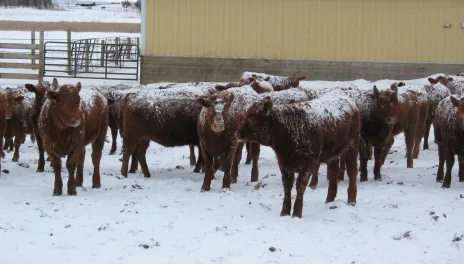Cattle feeding profits depend on input costs, rate of gain
Feed prices have increased over the past few years. According to the USDA feed price index, overall feed prices for livestock and poultry are up 26.6% from September of 2020 through September of 2022.
Higher feed costs directly cause higher cost of gain for feedlot cattle. However, cost of gain is also influenced by the rate of gain or average daily gain (ADG) for calves.
Using the following feed prices:
| Feed | Price | Unit |
|---|---|---|
| Alfalfa ha | $175.00 | ton |
| Grass hay | $125.00 | ton |
| Grass alfalfa hay | $150.00 | ton |
| Corn silage | $55.00 | ton |
| Corn grain | $6.40 | bushel (56#) |
| Dried distillers grains | $250.00 | ton |
| Limestone (cal carb) | $6.50 | 50 pounds |
| Trace mineral salt | $9.50 | 50 pounds |
| Sex | ADG (pounds) | Weight Range (pounds) | Feed Cost of Gain |
|---|---|---|---|
| Steers | 1.8 | 500 to 800 | $0.79 |
| Steers | 2.8 | 525 to 805 | $0.62 |
| Steers | 3.6 | 575 to 1270 | $0.68 |
| Heifers | 1.8 | 450 to 756 | $0.80 |
| Heifers | 1.8 | 550 to 848 | $0.81 |
| Heifers | 2.8 | 525 to 805 | $0.62 |
As rate of gain increases, feed cost of gain usually decreases. However, at 3.6 pounds ADG, the cost of gain is actually higher than the 2.8-pound ADG cost of gain. This is due to the price differential between corn grain and corn silage. The 2.8-pound ADG used 68% corn silage (as fed basis) at $55 per ton. The rule of thumb comparing corn silage to corn grain is that the cost per ton of corn silage is 8 or 9 times the price of corn grain per bushel. Of course, the price of corn silage can vary greatly depending on production yield, production costs and moisture content.
Light-weight steer calves gaining 1.8 pounds per day would need a 0.34 Mcal per pound net energy ration. This can be accomplished with many ration formulations, but the example here used a 0.34 Mcal diet containing 34% grass hay, 58% corn silage and 2.5% dried distiller grains (as fed basis) for 1.8 pounds ADG.
Steers gaining 2.8 pounds per day need a 0.45 Mcal per pound net energy ration. This ration included 14% grass hay, 68% corn silage, 9% corn grain and 9% dried distiller grains.
To reach a 3.6-pound ADG, the final ration would require an average ration of 0.55 Mcal or better, consisting of 9% grass hay, 43% corn silage, 41% corn grain, 7% dried distillers grains and 0.3% calcium carbonate. If the calves are fed to finish, the finishing ration would need to be 0.62 Mcal or more during the final months on feed.
Please keep in mind that body condition can affect selling price: fleshy cattle may be discounted severely. Match rate of gain, days on feed and type of cattle to prevent discount pricing.
Keeping feed costs low, performance high and purchase costs affordable can make feeding cattle in North Dakota an opportunity for the winter season of 2022-2023.
For more information on marketing, budgets, health and nutrition for backgrounding calves, go to https://www.ndsu.edu/agriculture/ag-hub/ag-topics/livestock/beef/production/backgrounding-cattle.
Karl Hoppe
Karl.Hoppe@ndsu.edu
Extension Livestock Systems Specialist
